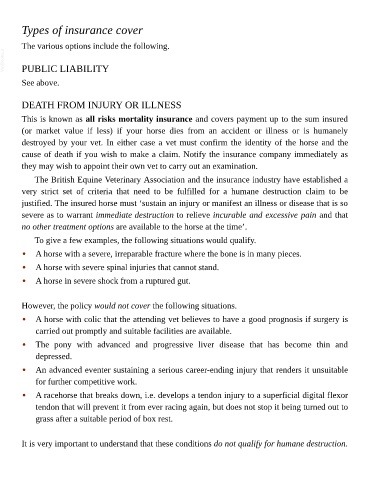Page 1105 - The Veterinary Care of the Horse
P. 1105
Types of insurance cover
The various options include the following.
VetBooks.ir PUBLIC LIABILITY
See above.
DEATH FROM INJURY OR ILLNESS
This is known as all risks mortality insurance and covers payment up to the sum insured
(or market value if less) if your horse dies from an accident or illness or is humanely
destroyed by your vet. In either case a vet must confirm the identity of the horse and the
cause of death if you wish to make a claim. Notify the insurance company immediately as
they may wish to appoint their own vet to carry out an examination.
The British Equine Veterinary Association and the insurance industry have established a
very strict set of criteria that need to be fulfilled for a humane destruction claim to be
justified. The insured horse must ‘sustain an injury or manifest an illness or disease that is so
severe as to warrant immediate destruction to relieve incurable and excessive pain and that
no other treatment options are available to the horse at the time’.
To give a few examples, the following situations would qualify.
• A horse with a severe, irreparable fracture where the bone is in many pieces.
• A horse with severe spinal injuries that cannot stand.
• A horse in severe shock from a ruptured gut.
However, the policy would not cover the following situations.
• A horse with colic that the attending vet believes to have a good prognosis if surgery is
carried out promptly and suitable facilities are available.
• The pony with advanced and progressive liver disease that has become thin and
depressed.
• An advanced eventer sustaining a serious career-ending injury that renders it unsuitable
for further competitive work.
• A racehorse that breaks down, i.e. develops a tendon injury to a superficial digital flexor
tendon that will prevent it from ever racing again, but does not stop it being turned out to
grass after a suitable period of box rest.
It is very important to understand that these conditions do not qualify for humane destruction.

